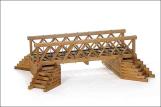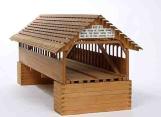2
OLD FLOATING BRIDGEThis picture of the Old Chemong Floating Bridge shows how the Pigeon Creek Floating Bridge would have looked. The bed of the bridge would be at water level and the bridge "moved" when a heavy team was crossing making the journey particularly unnerving especially in rough weather.
4
PIGEON CREEK FLOATING BRIDGEThe floating bridge across Pigeon Creek depicted in this model was constructed in 1869. It was a long bridge by pioneer standards being approximately three-quarters of a mile in length and extended across two township lots. This type of bridge was suspectible to damage from stormy waters, high winds and the build-up of ice in the winter. The bridge was destroyed by ice and wind in the spring of 1920. The model represents only a portion of the actual bridge. The ramps at either end of the bridge allowed for the rise and fall of the water. The bridge had a wide section to allow traffic to pass as well as a removable section to allow for the passage of boats and rafts.
6
OLD MILL BRIDGEThe Mary Street Bridge, often referred to as the 'Mill Bridge' was originally made of log and built in 1825. It was later reinforced for heavy traffic. It was located at the site of the old grist mill, and can be seen from Highway No. 7 where it crosses the Pigeon River. It was later replaced with a bridge containing several iron spans. This model of the bridge, as of 1875, is to a scale of ½ in. to 1 ft.
8
BROWN'S BRIDGEThis model depicts a typical small bridge which would cross small streams throughout the area. It has a corduroy floor ( logs) over which the carriage would bump along. It is a simplistic design with logs jutting into the adjoining banks to hold it secure.
10
OMEMEE RAILWAY BRIDGEThe model depicts the bridge that was constructed in 1855 over the Millpond on the Pigeon River. White cedar was used for the piers with the main or king truss being white pine, the preferred timber for bridge construction. As repairs were necessary over the coming years, the piers were reinforced with oak piles and heavy Douglas fir beams were placed on the piles and the white pine king truss was removed.
The bridge was altered to accommodate wide gauge rail traffic and later changed to standard gauge. The rails were removed in the late 1920' and the bridge was used for regular vehicular traffic.
12
KING STREET BRIDGE MODELThe model shows the King Street bridge with sidewalks and is the first recorded bridge in this location with walks for pedestrians. It represents the bridge in existence in 1875 which was replaced in the 1880's by a single steel truss on limestone piers. There is now a concrete bridge in this location forming part of the former Queen's Highway No. 7
Men felling oak trees into streams, which they then walked over, made the first bridges and the first bridge in this location was probably constructed of logs. This model is of the second bridge at this location. For many years, there were signs at either end reading 'Anyone crossing this bridge at a pace faster than a walk will be prosecuted.' This may have applied to horse and buggy days, but definitely not for automobiles. In 1933, the Ontario Department of Highways replaced the iron bridge with a concrete bridge
14
Williamstown Covered BridgeThere is no record of covered bridges being constructed in the Omemee or surrounding area, however Mr. McCrea included a covered in his model collection. He stated that this bridge spanned the River aux Raisin (commonly called the Black River) at Williamstown. It would appear that Mr. McCrea did not actually see the bridge but based his model on a post card which he received from a Mr. J.B.McLennan who served with him in South Africa. He used magnifiers and based his calculations on the photo in order to construct his model. The covered bridge offered protection to the horse and rider while crossing the waterway and are considered picturesque.






